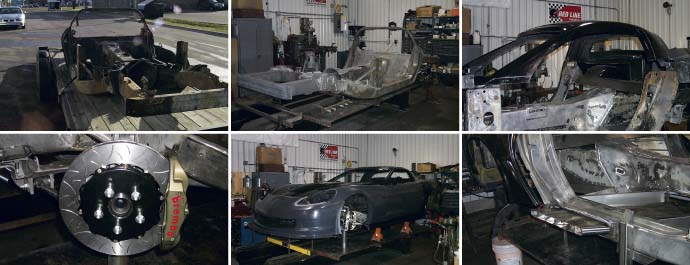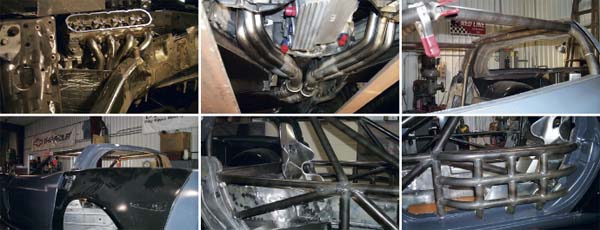 |
. . .Playing by the Rules
SWC racecars are supposed to
look like they came right off a showroom floor. Don't believe the hype—in
the first of two parts, Jeff Glenn goes inside Doug Rippie Motorsports to see
the extras SCCA doesn't talk about.
Photos by
DRM.
Building an SCCA SPEED World
Challenge machine ought to be easy. This is a series for production-based cars
with sealed engines and strict controls over modification. They look like
something you'd find in your driveway, only with gutted interiors, more
stickers, no ride height, and big wheels. Get a car, get a MIG welder, and
you're ready to hit the track, right?
Not exactly. And here's why:
Because racing is all about rules. Not speed. Not glory. Not bravery. Not
technology. Rules.
|
Which makes sense, really. Without rules, every race
for the last 30 years would've been won by a Saturn V rocket. The object isn't
really to go fast as you can, but to go fast as you can under a precisely
circumscribed set of conditions. At the most fundamental level, it's in the
meeting, probing, rethinking, and sometimes flouting of the rules that all
races are won or lost. If it weren't, the guy with the NASA patches would just
win every time.
Now narrow that idea down to the realm of Corvette
racing—the SCCA SPEED World Challenge, in particular. This series, which
fits somewhere between amateur club racing and GM's assault on Le Mans, grew
out of Showroom Stock of the '70s and '80s. The latter is remembered today as
yet one more once-popular series that proved cheap racing never remains that
way. In its latest SWC incarnation, the series doesn't even pretend to be
cheap. Instead, the rulebook lays out a season of 50-minute sprint races with
enough TV coverage and car-to-car equalization to tempt dozens of high-rolling
race teams to take their favorite brands to the track. Corvettes compete in the
GT category against a wide range of coupes and sedans sporting anywhere from
425 to 550 horsepower. The SCCA would love you to think these are quite like
the cars you and I drive, but that is a big, fat lie.
Just ask amateur racedriver Ed Braswell. Braswell
worked his way up from club racing and is ready to take on the World Challenge.
When he isn't driving Ed runs a successful construction company out of the
Florida Keys, so funding is not a huge problem. Last year he sampled a C5-era
Z06 in the series, but after carefully reading the rules—you see a theme
coming here—he came to believe that a C6-based entry was smarter. Under
SWC rules the Z06's aluminum frame is illegal, and even a regular C6 has to
weigh 50-odd pounds more than a C5. On the other hand, it gets to run more
displacement, the transaxle sits farther back, and—if clad in light
carbon-fiber bodywork—the extra mass can be placed very close to the
ground.
Ed contacted Doug Rippie Motorsports, with whom he'd
already built several street and track cars, with his goals and his budget;
Braswell figured his "production" Corvette racecar would set him back about 150
grand. For one-sixth that he could've gone faster in a secondhand Formula
Mazda, but that was beside the point. Different series. Different rules. Apples
and oranges.

Doug Rippie cut his teeth on Corvettes. The man
grabbed a '72 regional championship in SCCA with one and built his own '84 GT1
version to win a Central and National Championship. He co-drove winning
Showroom Stock C4s and earned big Corvette credibility with a star-studded
driver lineup for '88 and a dominant four-car team in '89. Then came a '92
World Challenge title, a '95 Le Mans entry, simultaneous high-output street
programs.... You get the idea: DRM had been through this drill before. They
knew how to read rulebooks and knew how to come up with competitive racecars.
They even knew Ed Braswell and knew that he'd see it through. The only thing
different this time around was that Rippie would be letting us ride into the
storm with him along the way. And what we found out in the process surprised
us.
For one thing, you'd think it would all start with a
shiny new C6, or at least with a shiny new C6 chassis. Au contraire. Why spend
a pile of money on something shiny when the ugly but perfectly usable
equivalent can be had on eBay for 750 bucks?
The chassis arrived in October, considerably burnt
around the edges having just come through a summertime LA County firestorm. DRM
knew they could treat the charred chassis exactly the same as they would a
brand-new one—pine-tree fires don't get hot enough to damage steel, they
just make it look pretty darn awful.
After stripping away all the glues and coatings and
cutting out the burnt cinders of flooring and gas tank, DRM hauled the frame to
a local commercial stripper. There it was bathed for the better part of two
weeks in a heated, electrolysis-inducing solution charged with five volts of
electricity.
After its refreshing vacation at the chassis spa, the
frame came back to DRM a little easier on the eyes and a lot easier on the
welding gear. In no time at all it was flipped upside-down and the original
jacking points were removed, reinforced with tubing and steel plate, and
reinstalled. "The stock points on the frame tend to get crushed with all the
jacking a racecar endures," Rippie says. "Plus, since the car will end up too
light [by SWC rules] at the end of the build anyway, it's a nice place to add a
little weight way down low." Provisions for holding the new fuel cells were
fabricated at the same time.
The chassis was then righted and all non-essential
brackets were removed. Next on the schedule was supposed to be fitting the
bodywork, DRM's plan calling for mocking up the new skin before beginning the
welded-in rollcage. Fine idea, except that the body parts never showed up. To
kill time the shop started fabricating the engine mounts, headers, and exhaust
system instead, using an empty block as a template built out with correct
cylinder heads and the right dry-sump pan.
"It's important not to forget the head gaskets when
making this stuff," Rippie muses. "If you don't, suddenly everything no longer
fits during assembly." Sounds like the voice of experience to us.

Two sets of headers were constructed, one boasting
marginally longer primary tubes than the other. These will be interchanged as
needed to set up the car for faster tracks like Road America or twistier ones
like Infineon. Fabrication of the terminal outlet was made more complex by the
use of a Boom Tube-type tip. This flat, wide dump system was originally dreamed
up by aerospace engineer Boyd Butler and first used in NASCAR during the
mid-1990s. By swirling the exhaust in a way that creates lower pressures than
regular outlets, the Boom Tube puts out a higher-frequency sound with fewer
decibels and a small but noticeable rise in volumetric efficiency. Adapting the
system to the Corvette required cutting a slot through the chassis, reinforcing
the frame all around the hole, and carefully reshaping the floors on the
passenger's side to maintain ground clearance at roadracing ride heights.
Rippie has had luck with these units in the past, but you never know: If it
doesn't deliver for Braswell, they'll have to reshape the chassis to fit a
conventional system.
Carefully reading the rulebook started the work under
the hood as well. As determined by SWC officials, the engine in a GT entry can
be balanced and blueprinted but can only use its original parts or pieces of
equivalent size and weight. Once it's been checked for compliance, officials
even seal up the engine to discourage creative tampering. Dry-sump oiling and
engine-management software are open, while traction-control isn't allowed.
DRM ordered the parts for the engine in December. By
the first week of February the six-liter, LS2-based short block was assembled
and its cam timing had been set. The rules don't allow significant mods to the
heads, only changing out valves and springs.
Just as they were prepping the motor for its first
dyno session, DRM got a call from the SCCA looking to schedule its SWC GT
inspection. "I figured they'd want to see all the paperwork on the parts, see
the boxes, and then seal up the engine as soon as we bolted the heads on."
Instead, once the inspector flew out he wanted to weigh the crankshaft and all
the internals. That meant DRM had to disassemble the built-up block, let the
inspector do his thing, then put everything back together a second time. All
told, this ate up a week of the already tightening schedule.
The much-delayed bodywork showed up in the third week
of January. Frustrating, but there wasn't much DRM could do about the
delay—the way the rules were written, it could only be purchased from one
supplier.
The new carbon skins were temporarily placed over the
chassis, after which the stock B-pillar halo structure was removed to make way
for the new cage. Between the low-volume, handmade composite parts and the
one-off construction of the cage and brackets, fitting a new car's bodywork and
substructure is always a time-consuming puzzle: Put a piece on, mark where it
needs to be modified, take it back off, cut it, sand it, refit it, mark it
again. The process repeats itself over and over until every piece relates
perfectly to the rollcage, the chassis, and all of its external neighbors.
The rulebook allows a fair bit of modification to
brake hardware, so a system was laid out with huge rotors, Brembo monobloc
calipers, and air ducting right through the rails of the chassis. "We grab the
air and put it into the frame rail, then direct it out near the wheel and
attach a duct there; that way you're not fighting all that ducting stuffed in
the suspension when you're trying to turn. We've done it that way since '92,
and now several others are doing the same thing," Rippie says. The hardware was
mocked into place pending the arrival of several key suspension components from
Pratt & Miller, another SCCA-mandated supplier. It's legal to move the
front-suspension pickup points by up to 25mm, but doing so isn't always
successful. The geometry change demands careful calculation lest the effects
come out unpredictably.
With the Corvette's debut scheduled for the first
race of the season at Sebring on March 15th—SWC will be an appetizer to
the 12-hour ALMS season-opener—DRM expects a busy month ahead. It's hard
to predict the snags and traps they'll hit next, but when I ask if he figures
they'll make it, Rippie pulls out his poker face. "Oh, it's too early to tell,"
he says. "We're waiting on some key pieces and there have been delays with
several suppliers. We'll know pretty soon."
You have to assume it's a routine Rippie's gone with
before; either way, CM intends to stick around and find out. Hopefully, the
second half of this story will see Ed Braswell driving the car on its first
laps at Sebring. In the next issue we'll know for sure.


